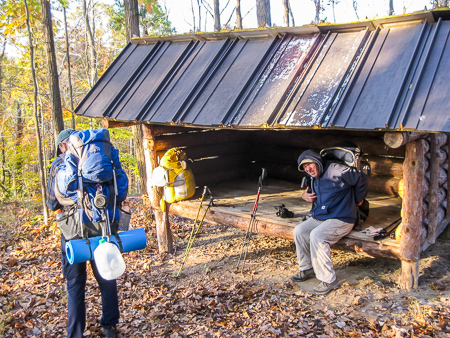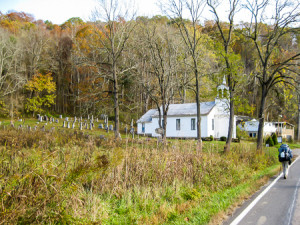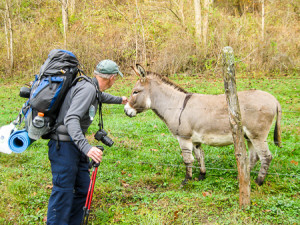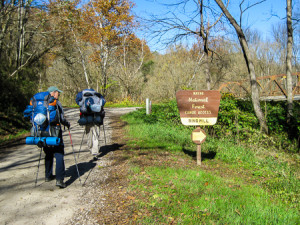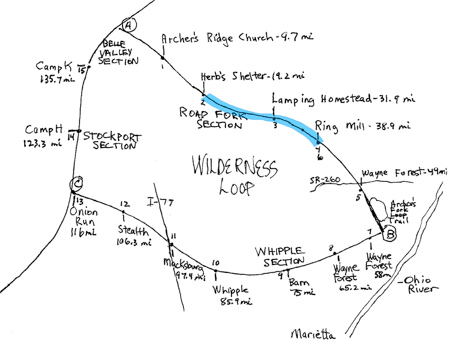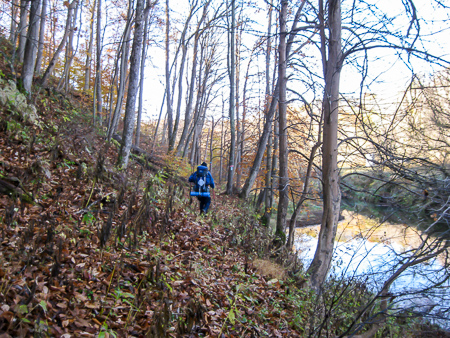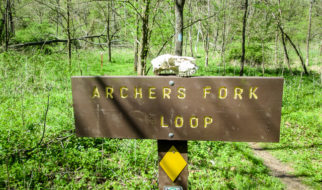Part 1, Part 2, Part 4, Part 5, Part 6, Part 7
March 14, 2015
To the Forest’s Edge
Sometime during the night, I awoke to a loud yelp, unlike any I’d ever heard before. A second or two passed before I realized I was being treated to my first coyote serenade. Sounded like it came from the road, only a couple hundred feet from the shelter. The concert ended as quickly as it had begun, followed by barking from the top of the ridge. I figured that had to be Michelin Muncher (see Part 2) or one of his buds.
With a liner added inside my bag, I was uncomfortably warm, but too tired to get up and remove it. We weren’t following the news and weather, so I didn’t know it would only get down to 42 degrees that night. Maybe the thing to do is to start light. I might be more motivated to crawl out of my bag if I need to add layers to keep from freezing.
We left Herb’s hut at 8:45 the next morning. He had sold his property there years ago, but with the understanding that the log shelter would remain open to BT hikers. We were three grateful benefactors of his foresight. As we climbed the hill and turned left onto High Water Road, George and I made sure we had our pepper spray containers drawn and ready, the nozzles of our trusty weapons pointing away from us. I didn’t know Jim’s plan. Maybe he had a dog biscuit in his pack. Or possibly a small tire for Michelin Muncher to chew on. Jim’s a smart guy. However, we found the road ahead unguarded. It wasn’t until we passed the house that I turned around and saw the critter, sitting beside the porch, as peaceful as a lamb. I attributed this pleasant non-encounter to Bonnie and two of our friends who had been praying for us old guys on the trail. Hey, it worked for Daniel.
We descended gradually to SR 260 and on past Road Fork Church. Then a short walk on 145. Seven or eight cars passed us before we turned off onto Cub Run, as many as we’d seen on all the rest of our hike so far. The road ahead was relatively level and easy to traverse. I would need all the help I could get since the day’s journey to camp at Lamping Homestead was almost 13 miles.
We came upon a field where a donkey and two small horses resided. George identified the first as a Jerusalem Donkey because of the distinct cross-shaped marking on its back and shoulders. Never having seen one before, I made a mental note to read up on it when I got home.* Farther along we were intrigued to see a satellite dish attached to an old, abandoned-looking house, but we had too many miles left to see if there might be a 50-inch flat screen inside.
We trudged up a winding, half-mile incline, taxing enough that we found a spot at the top to sit down and take a breather. There we met our first walkers in 25 miles, a lady and her grandson. The youngster excitedly pointed out a pumpkin spider crossing the road. Appropriate, it seemed, since Halloween was only a few days off. It didn’t have much to worry about as far as traffic was concerned. We enjoyed talking with our new acquaintances, but soon parted to finish our last miles. A while later, we found a cow loose on the road. Even stranger than that was the long, white stripe along its spine. Some other cows inside the fence must have been related. I added another mental note to look up “skunk cows” when I got home.**
This had been a day full of firsts. It was plain to see, however, that our arrival at camp was not. A group of a dozen or so hunters had already made camp, very close to our ravioli, corn, and jugs of water. Two monstrous tarps had been erected over their tents and equipment. Looked like they had all the comforts of home. They stared as I walked over and retrieved our water and cans, not three feet from one of the tarp stakes. Had our supplies really gone unnoticed? That would be good news for the deer in the surrounding forest. But maybe our neighbors had seen our stash and were courteously letting it be.
After we ate, I checked my feet for blisters. I was relieved to find none—not even a hot spot. I hadn’t been sure how my new Salomon boots would do for road walking, but they were proving to be up for the task. Or maybe older feet really are tougher. We talked for a while, but the darkness brought on a lot of yawns. Once again we went to bed with the chickens. That makes for long hours in our tents. We listened to the coyotes again. We also listened to the hunters partying well into the night, competing with the noisy canines for the loudest yips and yelps.
When we readied to leave the next morning, I was still yawning. After the long mileage the day before—and the big party overnight—I didn’t have a lot of energy. Luckily, camp lay only seven miles away. My mind wouldn’t be overworked either, with just one thing to remember that day: turn on my phone and check for a signal at the top of the lone large hill between us and Ring Mill. I had been able to talk to Bonnie every day so far, a pleasant surprise to both of us considering the spotty phone reception I had experienced on previous hikes in this remote area.
Our walk was basically a stroll. The only traffic was on the short stretch of SR 26 we had to navigate before we turned east onto Jericho Low Gap Road. Closer to camp, we startled a large flock of turkeys into flying across the Little Muskingum River. We arrived before one o’clock, making it a very short day. When I passed the Ring Mill sign, I immediately realized that I had forgotten to check my phone earlier. After lunch George and I climbed the steep hill behind camp. At the top I was rewarded with a good signal. My phone displayed an unusual “T” in front of the four bars. When I mentioned it to Jim, he said that was probably a cross, seeing that it was Sunday. Like I said, Jim is a smart guy.
We had a big fire and actually stayed up till 9:30. We slept on the picnic tables. It seemed like a good idea until the 32-degree air settled underneath them just before dawn. I could have gotten up and put on another layer of clothes, but it was FREEZING OUT THERE.
During the first four nights of our hike, I literally lay awake for hours. This is common for me when I backpack. Maybe it’s just hard to unwind from the intense exercise of each day’s hike. It’s not so bad, though. I get a chance to catch up on praying, to count my blessings, and to gain an appreciation for the soft bed I left at home. That night at Ring Mill, I also spent time relishing the fact that in the morning we would go off road and enter the scenic Wayne National Forest.
*Most donkeys have the cross but on some it is so faint that it is nearly invisible. One legend states that donkeys were a solid color when a donkey bore Jesus into Jerusalem on Palm Sunday; they received the markings of the cross after Jesus was crucified on Good Friday.
**Ha! There really are “skunk cows,” but their real name is Lineback Dairy cattle.

